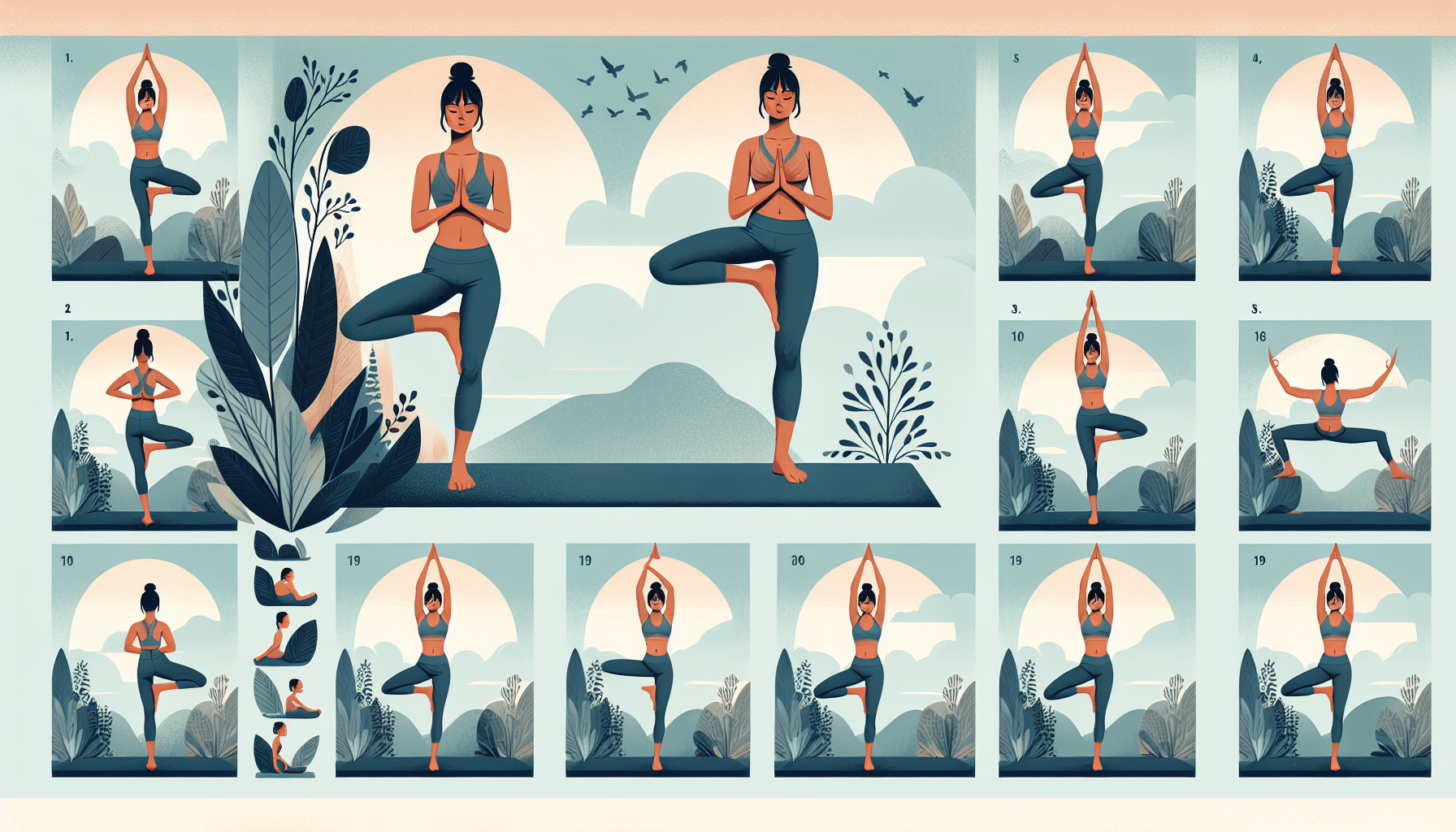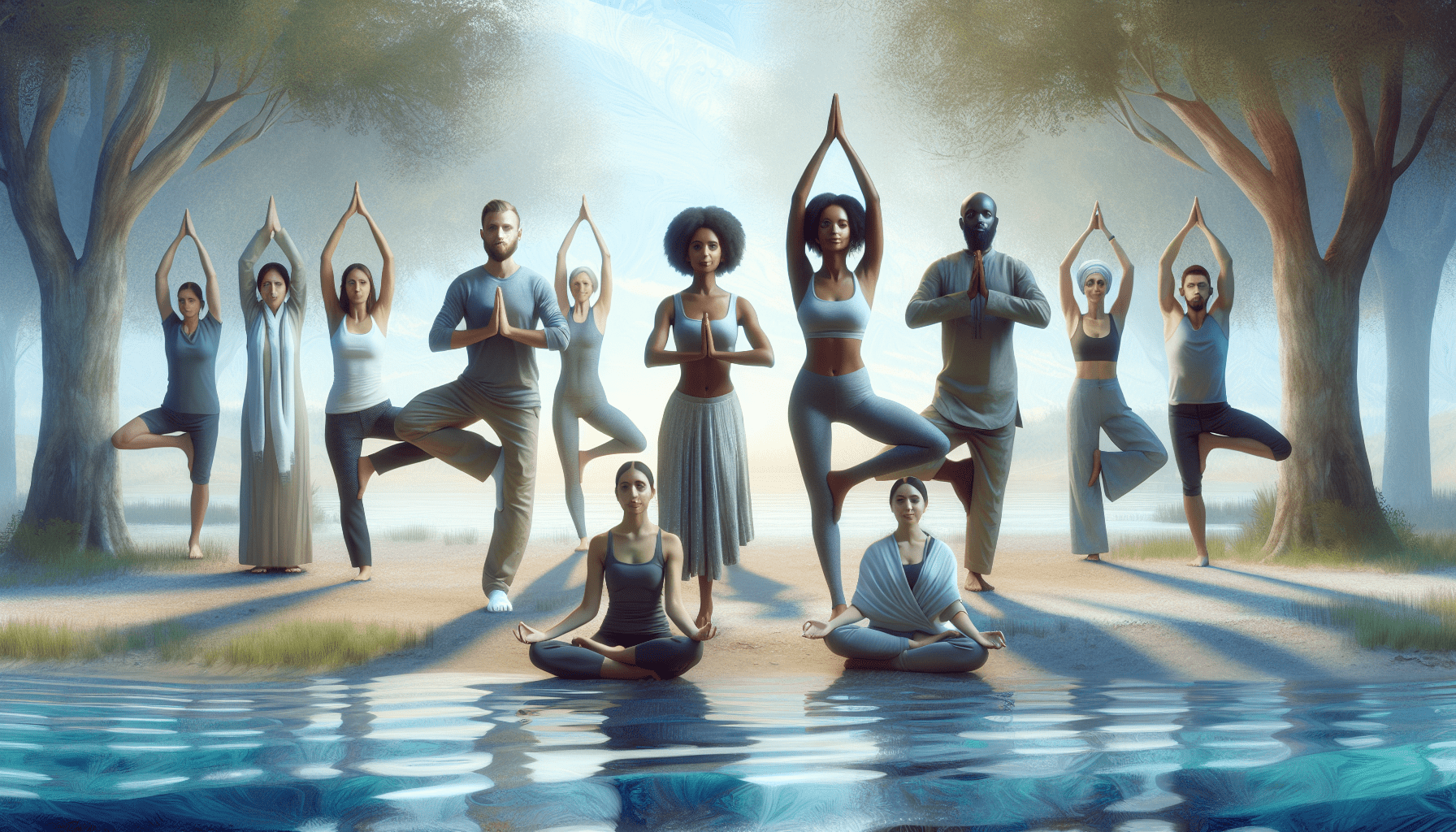Looking to improve your balance? Look no further than yoga. Yoga poses not only promote flexibility and core strength, but they also enhance your mind-body connection and proprioception – all crucial aspects of maintaining equilibrium and longevity. By placing emphasis on the feet and their support in various poses, yoga helps you develop a solid foundation for balance. If you’re ready to find your center and improve stability, try incorporating poses such as mountain pose, tree pose, warrior III, high lunge pose, standing forward fold, chair pose, and half moon pose into your yoga practice. By holding each pose for 5 to 10 breaths, you’ll soon notice an improvement in your stability and overall sense of balance.
Mountain Pose
Description of Mountain Pose
Mountain Pose, also known as Tadasana, is a simple standing pose in yoga. In this pose, you stand tall with your feet rooted firmly on the ground, aligning your body from head to toe. It is called Mountain Pose because it mimics the strength and stability of a mountain.
Benefits of Mountain Pose
Mountain Pose offers numerous benefits, particularly in improving balance. By focusing on the feet and their connection to the ground, this pose enhances proprioception, which is the body’s awareness of its position in space. By strengthening the muscles of the feet and legs, it provides a stable foundation for balance. Mountain Pose also helps improve posture and alignment, promoting proper body mechanics and reducing the risk of falls.
Step-by-step instructions
To practice Mountain Pose, follow these steps:
- Stand with your feet hip-width apart and arms hanging naturally by your sides.
- Distribute your body weight evenly through your feet and make sure all four corners of your feet are grounded.
- Engage your leg muscles and lift your kneecaps slightly.
- Lengthen your spine and imagine a string pulling you up from the crown of your head. Relax your shoulders and straighten your arms.
- Soften your gaze and take slow, deep breaths, feeling the connection between your feet and the ground.
Tips and variations
- If you have trouble balancing, you can practice Mountain Pose with your back against a wall for support.
- To challenge yourself and further improve balance, try closing your eyes while in Mountain Pose. This will heighten your body’s reliance on proprioception.
Tree Pose
Description of Tree Pose
Tree Pose, or Vrksasana, is a standing balance pose that mimics the grace and strength of a tree. In this pose, you stand on one foot while the other foot is placed on the inner thigh or calf of the standing leg, with your arms raised overhead like branches.
Benefits of Tree Pose
Tree Pose not only improves balance but also strengthens the legs, ankles, and core muscles. By grounding the standing foot firmly into the ground and engaging the muscles of the standing leg, this pose enhances stability and proprioception. Tree Pose also promotes focus and concentration, calming the mind and reducing anxiety.
Step-by-step instructions
To practice Tree Pose, follow these steps:
- Start in Mountain Pose with your feet hip-width apart and arms by your sides.
- Shift your weight onto your right foot and bend your left knee, placing the sole of your left foot on the inner thigh or calf of your right leg.
- Ensure your standing foot is rooted into the ground, creating a strong foundation.
- Bring your hands together in a prayer position at your chest or raise your arms overhead like branches.
- Find a focal point to gaze at and maintain your balance. Take slow, deep breaths and enjoy the stability and grounding sensation.
Tips and variations
- If placing your foot on the inner thigh is challenging, you can rest it on the calf or ankle instead.
- To make Tree Pose more challenging and improve your balance further, try closing your eyes while in the pose. This will heighten your body’s reliance on proprioception and increase the difficulty.

Warrior III
Description of Warrior III
Warrior III, or Virabhadrasana III, is a powerful standing balance pose that resembles a warrior in mid-air. In this pose, you stand on one leg while extending the other leg back, parallel to the ground, and your upper body extends forward, creating a straight line from head to toe.
Benefits of Warrior III
Warrior III not only strengthens the legs, core, and back muscles but also improves balance and concentration. By challenging your stability and engaging the muscles of the standing leg, this pose enhances proprioception and overall body awareness. Warrior III also promotes mental focus and determination.
Step-by-step instructions
To practice Warrior III, follow these steps:
- Begin in Mountain Pose with your feet hip-width apart and arms at your sides.
- Shift your weight onto your right foot and start to hinge forward at your hips, extending your left leg straight back.
- Straighten your standing leg but keep a slight bend in the knee to avoid locking the joint.
- Reach your arms forward alongside your body and extend them parallel to the ground, palms facing each other.
- Engage your core muscles and lengthen through your spine to create a straight line from your head to your lifted foot.
- Find a point on the floor to focus your gaze and maintain your balance.
- Hold the pose for a few breaths, then slowly release and switch to the other side.
Tips and variations
- If balancing on one leg is challenging, you can practice Warrior III with your back against a wall for support.
- For an extra challenge, try performing Warrior III with your arms extended overhead, creating a “Superman” variation.
High Lunge Pose
Description of High Lunge Pose
High Lunge Pose, or Utthita Ashwa Sanchalanasana, is a dynamic standing pose that requires balancing on one leg while the other leg is extended back in a lunge position. This pose challenges both balance and strength.
Benefits of High Lunge Pose
High Lunge Pose improves balance, strengthens the legs, and stretches the hip flexors and hamstrings. It also opens up the chest and shoulders and improves posture. By holding this pose, you develop stability and concentration, enhancing overall body awareness and mindfulness.
Step-by-step instructions
To practice High Lunge Pose, follow these steps:
- Start in Mountain Pose with your feet hip-width apart and your hands on your hips.
- Take a big step forward with your right foot, bending your right knee to a 90-degree angle, making sure your knee stays directly above your ankle.
- Extend your left leg back, keeping it straight and the ball of your left foot grounded.
- As you inhale, lift your torso up and raise your arms overhead, reaching toward the sky.
- Lengthen through your spine and engage your core muscles. Feel the strength and stability in your legs as you hold the pose.
- Keep your gaze forward and breathe deeply, allowing the pose to ground you and improve your balance.
- Hold for a few breaths, then slowly release and switch to the other side.
Tips and variations
- To modify the pose and make it more accessible, you can place your back knee on the ground, providing additional support.
- If you are looking for a deeper stretch, you can add a side bend while in High Lunge Pose, reaching your arms overhead and leaning gently to the side opposite to the extended leg.

Standing Forward Fold
Description of Standing Forward Fold
Standing Forward Fold, or Uttanasana, is a gentle standing pose that involves bending forward at the hips and folding your upper body toward your legs. It is a beneficial pose for stretching the hamstrings, calves, and lower back while improving balance and focus.
Benefits of Standing Forward Fold
Standing Forward Fold offers numerous benefits, including improved balance, flexibility, and posture. By folding forward, you lengthen the spine and release tension in the neck and shoulders, promoting relaxation. This pose also calms the mind and can help relieve stress and anxiety.
Step-by-step instructions
To practice Standing Forward Fold, follow these steps:
- Begin in Mountain Pose with your feet hip-width apart and your arms by your sides.
- Take a deep breath in and as you exhale, hinge forward at your hips, bringing your torso toward your legs.
- Allow your head and neck to release and relax. Bend your knees slightly if needed to maintain a gentle stretch in the back of your legs.
- You can either place your hands on the floor beside your feet or hold onto opposite elbows and let your upper body sway gently from side to side.
- Breathe deeply and sink deeper into the pose with each exhale, feeling the lengthening and opening of the back of your body.
- Stay in this pose for a few breaths or longer, focusing on your breath and allowing the pose to bring you a sense of grounding and stability.
- To come out of the pose, inhale and slowly roll up, stacking one vertebra at a time, until you reach a standing position.
Tips and variations
- If you find it difficult to reach the floor with your hands, you can use blocks or place your hands on your shins for support.
- For a more active variation, you can add a gentle sway or a standing forward fold with a twist, alternating between sides.
Chair Pose
Description of Chair Pose
Chair Pose, or Utkatasana, is a standing pose that mimics the shape of sitting on an imaginary chair. It is a challenging pose that requires balance, strength, and stability throughout the body.
Benefits of Chair Pose
Chair Pose improves balance, strengthens the legs, and tones the core muscles. By sitting back into an invisible chair and engaging the muscles of the legs and core, this pose enhances stability and proprioception. Chair Pose also strengthens the back muscles and improves posture.
Step-by-step instructions
To practice Chair Pose, follow these steps:
- Stand in Mountain Pose with your feet together and your arms by your sides.
- Inhale and raise your arms overhead, keeping the palms facing each other.
- As you exhale, bend your knees and sit back as if you were sitting on a chair, keeping your weight in your heels.
- Engage your core muscles and lengthen through your spine, keeping your chest lifted and shoulders relaxed.
- Imagine pressing your sitting bones back and down, creating a sense of stability and grounding.
- Maintain your balance by finding a focal point to gaze at and breathe deeply.
- To come out of the pose, inhale and straighten your legs, then lower your arms back to your sides.
Tips and variations
- If you struggle with balance, you can practice Chair Pose with your back against a wall for support.
- For an added challenge, you can try lifting one foot off the ground while in Chair Pose, holding the balance on the other foot.
Half Moon Pose
Description of Half Moon Pose
Half Moon Pose, or Ardha Chandrasana, is a balancing pose that resembles the shape of a half moon. In this pose, you balance on one leg while extending the other leg parallel to the ground and your upper body extends to the side.
Benefits of Half Moon Pose
Half Moon Pose improves balance, strengthens the legs, and stretches the hamstrings and side body. By challenging your stability and engaging the muscles of the standing leg, this pose enhances proprioception and overall body awareness. Half Moon Pose also builds core strength and improves concentration.
Step-by-step instructions
To practice Half Moon Pose, follow these steps:
- Begin in Warrior II Pose with your right foot forward and your left foot back. Your front foot should be aligned with the arch of your back foot.
- Inhale and shift your weight onto your front foot, lifting your back leg off the ground.
- As you exhale, reach your right hand forward and shift your weight onto your right foot while lifting your left leg parallel to the ground.
- Extend your left arm toward the sky, creating a straight line from your left fingers to your left heel.
- Engage your core muscles and lengthen through your spine.
- Find a point on the floor or at eye level to focus your gaze on, helping to maintain your balance.
- Take slow, deep breaths and feel the strengthening and stabilizing sensation in your standing leg.
- Hold the pose for a few breaths, then slowly release and switch to the other side.
Tips and variations
- If balancing on one leg is challenging, you can practice Half Moon Pose with your back against a wall for support.
- To deepen the stretch and challenge your balance further, you can use a block or prop your lower hand on the ground.
Other Yoga Poses for Balance
Description of other yoga poses for balance
In addition to Mountain Pose, Tree Pose, Warrior III, High Lunge Pose, Standing Forward Fold, Chair Pose, and Half Moon Pose, there are several other yoga poses that can improve balance. These poses include Eagle Pose, Dancer’s Pose, One-Legged King Pigeon Pose, and Crow Pose, among many others.
Benefits of other yoga poses for balance
Similar to the previously mentioned poses, these yoga poses for balance help improve stability, proprioception, and strength. Each pose targets different muscle groups and challenges different aspects of balance and concentration. By incorporating a variety of yoga poses for balance into your practice, you can enhance your overall equilibrium and coordination.
Step-by-step instructions
While providing step-by-step instructions for each yoga pose for balance is beyond the scope of this article, you can easily find detailed instructions and tutorials online or in yoga books. It is recommended to practice under the guidance of a qualified yoga instructor initially to ensure proper alignment and safety.
Tips and variations
- As with any yoga practice, it is important to listen to your body and modify or adjust poses as needed. If you feel any discomfort or pain, ease out of the pose or seek guidance from a yoga instructor.
- When practicing yoga poses for balance, always maintain a steady and focused breath. Breathing deeply and evenly can help calm the mind and enhance stability.
Breath Awareness and Stability
Importance of breath awareness for balance
Breath awareness plays a crucial role in achieving and maintaining balance during yoga poses. By focusing on the breath, you cultivate a sense of mindfulness and presence, which enhances your overall stability. Deep, conscious breathing helps calm the mind, reduce distractions, and improve concentration, making it easier to find and maintain balance.
How to incorporate breath awareness in yoga poses
To incorporate breath awareness in yoga poses, follow these steps:
- As you settle into a pose, start by taking a few deep, full breaths, filling your lungs completely.
- As you inhale, envision a sense of expansion and lengthening in your body.
- As you exhale, allow yourself to relax and release any tension or resistance.
- Focus on the sensation of the breath moving in and out of your body, anchoring your awareness to the present moment.
- Maintain a steady and rhythmic breath throughout the pose, letting it be your guide and anchor.
Benefits of focusing on breath for stability
Focusing on your breath during yoga poses not only improves stability but also promotes relaxation and a deeper mind-body connection. Breathing consciously helps to regulate the nervous system, calming the body and mind. By cultivating breath awareness, you cultivate a sense of inner stability and groundedness, which can translate to physical balance and overall well-being.
Duration and Repetitions
Recommended duration for holding each pose
The duration for holding each pose may vary depending on your level of comfort and experience. As a general guideline, it is recommended to hold each pose for 5 to 10 breaths. This allows enough time to fully experience the pose, activate the relevant muscles, and cultivate stability and balance. As you become more proficient, you may gradually increase the duration of each pose.
Importance of repetitions for improvement
Repeating yoga poses for balance is crucial for improvement. Regular practice helps to strengthen the relevant muscles, refine your alignment, and cultivate greater stability and proprioception. Consistency is key in building muscle memory and developing a deeper understanding of each pose. By incorporating repetitions into your practice, you can gradually progress and enhance your balance over time.
Guidelines for progressing in the poses
To progress in yoga poses for balance, consider the following guidelines:
- Start with foundational poses, such as Mountain Pose and Tree Pose, to establish a solid base and focus on the fundamentals.
- Gradually increase the duration of each pose, adding a breath or two at a time, as you build strength and confidence.
- Explore variations and modifications of each pose to challenge yourself and further develop your balance.
- In addition to static poses, practice dynamic sequences that involve transitioning between different balance poses, incorporating both strength and flexibility.
- Regularly reassess your alignment and technique, seeking guidance from a qualified yoga instructor when needed.
- Remember to be patient with yourself and enjoy the journey. Progressing in yoga poses for balance is a personal and individual process, unique to each practitioner.
Incorporating yoga poses for balance into your practice can have significant benefits for your overall well-being. By engaging in these poses and emphasizing breath awareness, stability, and mindful movement, you can cultivate a stronger sense of balance, both on and off the mat. Whether you are a beginner or an experienced yogi, exploring and refining these poses will help you establish a solid foundation for longevity and vitality. So, let’s embrace the transformative power of yoga and embark on a journey towards greater balance together!







